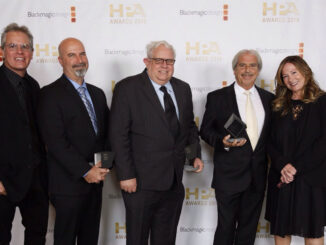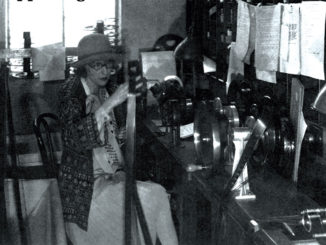
How a post-production team of 30 stayed healthy and got HBO’s hit on the air from home.
By Stephen Semel
It was Jonah Nolan’s idea. Jonah came to Kelly Calligan and me, the two post-production producers, and said he was convinced that it was only a matter of time before the coronavirus epidemic that had brought life to a standstill in parts of China and Northern Italy would come to the United States, and then to Los Angeles. Jonah and HBO wanted to air all eight episodes of our third season of “Westworld” on consecutive weeks, if possible. Would we look into what it would take to finish the episodes if there was a quarantine and all of us — producers, editorial staff, post-production staff, mixers, online editors, color timer — had to work from their homes?
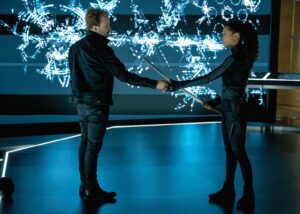
That conversation occurred on March 4, the day before our Season 3 Premiere screening at the Chinese Theater in Hollywood, and the fancy after-party next door at Hollywood & Highland. The Premiere episode, which I edited, would air March 15th. Joe Biden had just swept Super Tuesday. Earlier that day, I had purchased tickets to see Dave Chappelle at the Hollywood Bowl on May 2. Earlier that week, we had delivered the second episode to HBO. The stock market was tanking because of the coronavirus, true; and there was some speculation about cancelling our premiere and the party because of fear of the contagion, but it turned out to be a lovely evening. Jonah and Lisa Joy, our showrunners/co-creators, and also husband and wife, addressed the packed theater, everyone seemed to enjoy the episode, cocktails were imbibed, hugs and compliments were exchanged. The pandemic seemed far away.
Season 3 of “Westworld” had long been on what I like to call the Doomsday Schedule, where there are no days to lose without the price tag going up or the quality going down, in the process of finishing and delivering the episodes to HBO. All of the shows were picture-locked, so our picture editors were gone, but everyone else — assistant editors, post-production staff, the sound editing team, and Chris Kaller, our music editor — were all working 12+ hour days. And it was going to be crazy-intense for the next five weeks, until the last episode was delivered. How could we overcome the additional impediment of working from home?
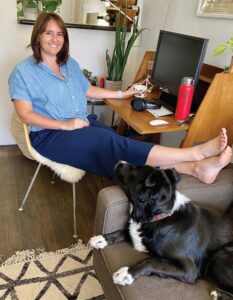
Together with Elena Beecher, the office manager of Kilter Films, the show’s production company, and Ron Madnick, Kilter’s tech advisor, we started to map out a plan to finish the season remotely. How many Avid systems would we need in assistant editors’ and visual effects editors’ homes? Would the editors have remote access to our shared server at Kilter, which held all the media files, or would each home system need its own local server? We knew that a big part of the solution would be Clearview Flex, the hardware/software system that allows streaming of picture and sound to remote computers. We had already used Clearview during the picture editing process while Jonah was on location in Louisiana on “Reminiscence,” Lisa’s feature film directing debut. How many Clearview boxes would we need to make our remote system work?
Next I contacted Universal Studios, where we mix, and Fotokem, our film lab and post-finishing house, to see what plans they were making in case of a shelter-in-place edict. How could we continue to mix the episodes if the mixers were quarantined in their homes? Could our color timer and conform editors work remotely? What was the lead time necessary to make those remote systems operational, and how would the untested process affect our delivery dates and the quality of the final product?
Then there was Visual Effects. Our Visual Effects Supervisor and Designer, Jay Worth, and the VFX Producer, Liz Castro, created the VFX production pipeline. Jay and Liz assign different VFX shots to different vendors, spread all over the globe. One vendor is great at fire effects, another at face replacements, yet another at world building. That was the most cost-effective, and creatively effective way to get through the massive volume of visual effects work that is “Westworld.” Our VFX team already had a murderous schedule without the added complication of the coronavirus. On the night of the premiere, March 4, roughly two-thirds of the season’s 3500+ VFX shots for the six remaining undelivered episodes had not been completed. What would happen to that VFX pipeline, to those many VFX vendors, if they were all required to shelter in place?
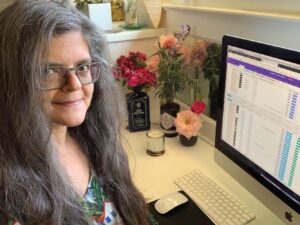
As the problems in China and Northern Italy turned into a worldwide pandemic, and we stopped calling it the coronavirus and started calling it COVID-19, some of our VFX vendors realized that their output would be seriously impacted when they had to switch to working remotely. They informed Jay and Liz that they wouldn’t be able to meet their deadlines for the last couple of episodes. And since we really couldn’t air the episodes without these visual effects, our delivery schedule was in jeopardy.
On Monday, March 16, the six San Francisco Bay Area Counties declared shelter-in-place, and we knew it was just a matter of days before Los Angeles was shut down. On Thursday, March 19, Governor Newsom declared shelter-in-place to be state law. On Friday, March 20, Kelly, Ron Madnick and I had a conference call with Dauri Chase, our HBO Post Production Senior VP; several HBO broadcast engineers; and Tom Vice, the Senior VP at Fotokem. Kelly, Ron, and I laid out our remote workflow plan for the HBO folks. Tom explained how he was setting up workstations in the homes of our color timer, Kostas Theodosiou, and our two conform editors, Alex Sanchez and Ismael Salas. Dauri’s headline was that she had conferred with the other departments at HBO and got them to agree that we could deliver the shows a week before they aired rather than 3 weeks, which was our normal delivery requirement. Now Visual Effects and the rest of our departments would have an additional 2 weeks to complete the work. Jay had already shifted shots away from the vendors who couldn’t meet the deadlines and given them to other VFX houses spread across the planet. So there was a path to delivery, if — and this was a big if — our remote plan held together.
By Monday, March 23, having already delivered the first four episodes to HBO, we went remote.
Our Avid vendor, Digital Vortechs, had moved four Avid systems into homes: assistant editor Yoni Reiss got one, VFX editor Jill Paget, and VFX assistant editors Andrew Trainor and Alexis Corrigan each got one. Assistant editor Tamar Feder had a software-only version of Media Composer on her home desktop system. Thomas Sabinsky had been the assistant on the season finale, which had the most work left to be done. He continued to work at Kilter Films. Other than our night security guard Rob Morgan, Thomas was generally the lone soul in an 8,600 sq. ft. building (I snuck in a couple of times to do something that I couldn’t do from home, but Thomas was on the first floor, and I was on the second floor).
Our on-site Avid server had been purchased and engineered to prevent remote access — i.e., security breaches. Given that there was no advance time to set up a new server that allowed remote access, Ron determined that each remote Avid would have its own offline server, which necessitated the rental or purchase of quite a few drives to accommodate the volume of media files at each home — anywhere from 6 to 15 terabytes.

Our standard was to honor the rule of shelter-in-place. In the case of our sound mix stage at Universal Studios, which remained open after March 23, the rule was no one working within six feet of anyone else. Though Fotokem decided to close its doors to all but a couple of maintenance engineers when shelter-in-place was announced, Universal took advantage of the law’s exception for media companies as essential businesses. Physical production at the studio stopped, and most of its employees worked from home, but some facilities, including our mix stage, remained open. Our mixers, Keith Rogers and Ben Cook (who is also our sound designer), and their recordist, Rick Camara, continued to mix from the stage. Had Universal shut the stage down, forcing Keith and Ben to work separately from their homes, we might have missed our delivery dates. Our sound supervisor, Sue Cahill, and Chris Kaller, the music editor, decided to work from home. On mix playback days, up to 15 producers, writers, film editors, sound and music editors, and VFX staff would join a Clearview streaming session from their respective homes, listening through their computers to a 2 track stereo mix, and typing their notes on an Excel document designed for the purpose of collating everyone’s notes. Afterwards, we’d all chat on a conference call, and review Jonah’s big concerns. Meanwhile, all the notes would be compiled and collated by Morgan Shaw, one of our post supervisors. Kelly Morgan, and I would stay on the Clearview session for the remainder of the work day, executing the notes with Keith, Ben, Sue, and Chris.
A couple of weeks into the remote mixing process, it was determined that as a precautionary health measure, Ben, who had a mix setup at his home studio, would work from home, which left just Keith and Rick on the stage at Universal. This made the process more cumbersome, since any sound effects content updates would first have to be made by Ben at home and then sent to the stage, but we persevered.
When the VFX vendors had a shot to send us, they would send both a small, low resolution QuickTime version and a full resolution DPX file to Matt Martin, the VFX production assistant. Matt would distribute the QuickTime files to the other members of the VFX team for review, and the DPX file would be sent on to Fotokem. Jay and the team, which included the VFX editorial staff, VFX production manager Jackie VandenBussche, and VFX coordinator Octevia Robertson, would review the shots, sometimes on their computers, sometimes collectively in Clearview sessions, while they spoke to each other on a conference call. In addition, there were many VFX review sessions with Jonah, executive producer Denise Thé, Kelly, sometimes the picture editor, and me. Shots that were deemed acceptable for the sound mix were sent in an EDL to the assistant picture editors, who conformed their versions of the picture and passed the new shots along to our sound and music editors and the mix stage. The VFX editorial staff would send new EDLs to Fotokem so that Alex and Ish, the conform editors, could add the approved shots to our color-timed master. Jackie, who had basically lived at Fotokem before shelter-in-place was declared, was responsible for keeping track of all of the versions of all the VFX shots, whether they were approved for sound but still in-progress or final versions cut into the CTM.
Fotokem had their act together. We lost a few days of color timing and a half day of conform editing before we resumed working remotely, nothing major. The home systems were slower because of the comparative internet signal strength of home vs. commercial facility (which was true everywhere in the process), but the work continued. Natalie Toto, one of our post supervisors, who had also pretty much lived at Fotokem in the weeks preceding shelter-in-place, was our main interface with Fotokem. Along with the participation of our Fotokem producer, Leena Gundapaneni, conform sessions continued, as did Clearview color timing sessions with Kostas, which were also attended online by Jonah and/or Kelly and me. When the show was about to be delivered to HBO, Leena would upload a ProRes version of the J2K delivery file to an encrypted server, and a number of us would download it to our home laptops or desktops, scrutinize it for problems — minor VFX imperfections, boom shadows or matte box flares that we hadn’t caught in previous passes, etc. Natalie would compile the list of problems, and they would be addressed and fixed — or if they were deemed too minor, expensive, or time-consuming, left alone. Then a revised file would be scrutinized by the same pairs of eyes, given the thumbs up, and sent to HBO for their QC process.
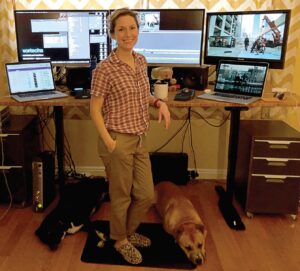
That left the issue of dirt, by which I mean negative dirt. “Westworld” shoots 35mm film, and negative dirt, which typically shows up as white spots on a positive image, is inherent to the medium. Before shelter-in-place, Fotokem used a combination of a computerized dirt removal system (DRS) and individual technicians to locate and paint out negative dirt. After their painstaking work, our post team would go through each show, shot by shot, to look for more dirt, and it would be painted out. Then, after the delivery file was sent to the network, HBO’s QC process would find more dirt, and it would be removed and a new delivery file sent to HBO. In pre-COVID-19 days, what you watch at home is pretty danged pristine. Natalie told me that on the first episode of Season 3, DRS spent 335 hours cleaning dirt. But now that Fotokem’s doors were shuttered, the dirt removal system was sitting idle, and those DRS technicians were home like the rest of us.
By March 23, the DRS process had been completed for the first five episodes, but the last three were not so fortunate. So each of those three episodes were divided into 4 parts, and Natalie, Morgan, our post coordinator Anastasia Moore, and Leena would frame through the cut, logging frames with dirt. Then Alex and Ish, using paint tools on their Resolve software, would paint it out. That’s a much slower and more cumbersome system than DRS, and so the delivered versions of the last three episodes, though pretty clean, were not the immaculate presentations that the first five were. There just wasn’t the time or resources.
ADR was also not a part of our process that transferred well to the shelter-in-place world. The cast of “Westworld” is a group of amazingly talented professionals, well-versed in what it takes to give a good performance on an ADR stage, but in quarantine there are no ADR stages available, and there is no substitute for getting a quality ADR recording. We didn’t have enough lead time to put together some other clever ADR option for our actors. So we decided we would live with the occasional noisy location track, which we often do anyway, and ask the actors to record only added dialogue on their iPhones. Some results were better than others. If the actor was quarantined in the center of a huge megalopolis, it was difficult to get a good recording. The majority of the cast recorded their lines deep in their closets or in their cars, windows rolled up. Loop Group was another beast altogether; rather than having a dozen group artists together in a room, recording it all onto two mics simultaneously, each group member recorded their tracks separately, which became a nightmare for the sound editors. Big shout out, however, to No. 1 on the call sheet, Evan Rachel Wood, who just happens to have a recording studio in her home. Her ADR was pretty flawless.
On Monday, April 27, just before midnight, Kelly, Natalie, Morgan, Leena, Anastasia, Ish and I finished checking the J2K delivery file for the season Finale in a Clearview session, before it went to HBO. We all gave it a thumbs-up. The Finale aired the following Sunday, May 3. Normally we’d be in the same room and have a bottle or two of champagne nearby to celebrate the end of 14 months’ worth of hard work. Given the number of hours we’d all spent in front of our laptops over the past six weeks, no one was even slightly interested in a virtual celebration on Zoom. Our celebration will have to wait.
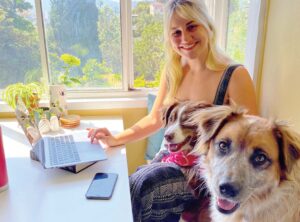
So how did we do? The episodes aired on consecutive weeks, as planned. HBO spent more on finishing the shows than they would have had there been no worldwide pandemic, but not so much more. If we’d had more time to design the remote workflow, we would have set up remote 5.1 systems in a few producers’ homes so that we could monitor that sound format instead of just listening to the two-track stereo that our laptops could handle. We would have installed color-corrected reference monitors in a few homes so that we saw what Kostas saw rather than what our laptop screens displayed. And we would have set up a better-quality streaming picture and sound signal from Clearview. Since the shelter-in-place orders, Clearview’s business has dramatically expanded, and based on the new needs of their customers, they have introduced new products that would have better met our needs. In our process, the image and sound carried by the Clearview Flex box was sometimes compressed, sometimes choppy, depending on the end user’s download speed or time of day; early-morning and late-night sessions looked and sounded better than sessions in the middle of the day, when all of Los Angeles was working from home. Far from ideal, but we made it work.
When Jonah originally pitched the idea of working remotely, he said we might have to accept delivering the final episodes with about 80% of the finish quality that we normally deliver. Kelly and I agree that we got to about 93%. But we wouldn’t have achieved that number without everyone on the team accepting and surmounting the unforeseen challenges of working from home. We all had to come up with solutions to problems that didn’t exist in the pre-COVID-19 workplace, and no one complained about it, at least not to me. The process was restricting: only Keith and Ben heard the 5.1 mixes before they were delivered, and only Kostas got to watch the color-timed masters on a color-corrected reference monitor before they went to the network, but we’d all worked together long enough to have a trust and shorthand that made it work.
“After the CDC announcement in late February that the pandemic would almost certainly reach the US, we began talking about possible strategies to complete the season,” Jonah Nolan wrote by email. “For the most part we benefited from luck — principal photography was done, as was most of the picture cutting, and we had been testing remote editing playback throughout the fall, as Lisa was shooting her film in New Orleans. But we still had a mountain to climb in terms of VFX and sound.
“I remember the seeming absurdity of that first conversation where we speculated that at some point we might be forbidden legally from coming to our offices,” he added. “Our post team, under the leadership of Steve, Kelly and Jay, did an incredible job coordinating with our team and our vendors to ensure measures were in place for everyone to be able to continue to work from home. We had to invent a lot of solutions on the fly — who knew that a car would make a good sound booth in a pinch? I’m incredibly proud of the work our team and our partners did to complete the season.”
Many of my colleagues said that they preferred the experience of working from home. They got to escape the often nightmarish Los Angeles commute times. I certainly didn’t miss my 75- to 90-minute morning drive. If they had young children, they had no choice but to be at home since their kids were not in school. Those with families got to eat dinner with them. If there was downtime during the day, they could attend to other responsibilities, whether work-related or domestic. For me, it was one of the few times in decades of working in the business that I consistently got to have dinner at home while working on a show. And we all recognized our good fortune in continuing to have jobs in a world where so many millions suddenly found themselves unemployed.
We hope you enjoy the show. ■



